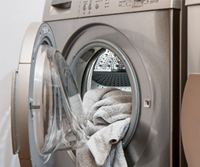Toilets
A quarter of all the water we use in the bathroom is flushed down the toilet
If you can, buy a top rated dual flush toilet, and look for models with a four-star water efficiency rating. These toilets use just 4.5 litres for a full flush and 3 litres for a half flush. This alone could save you up to 35,000 litres a year.
If you can’t afford a new toilet, put a water filled plastic bottle or a brick in your cistern to reduce the volume used with each flush. If you have an older toilet you could be using around 18 litres of water with each flush!
If you are building a new home or doing a bathroom renovation consider installing plumbing to flush your toilets using rainwater or greywater.
Don’t use your toilet as a bin - only flush the three Ps - pee, poo and paper. Pads and tampons, food waste, baby wipes and goldfish don't belong in the toilet! Flushing them not only wastes valuable water (and costs you money to fix if they block your pipes) but places additional strain on the sewerage system. Find out more about what can go down the drain.
Leaking toilets
A continuously running toilet can waste up to 60,000 - 96,000 litres of water a year - but people often don't even realise they have a leak because the water trickles slowly down the back of the bowl.
Follow these simple steps to check if your toilet has a leak:
- Remove the lid of your toilet cistern.
- Place a few drops of food dye into the cistern.
- Do not flush your toilet for 10-15 minutes.
- If the dye has seeped down into the bowl when you return, then you know you have a leak.
Toilet leaks are often a result of the rubber valve in the cistern deteriorating. You can contact a licensed plumber to fix this for you. It is important to check your toilet for leaks every few months so you can be sure it is not wasting any water.
How to check if your toilet is leaking
Discover ways to save water in more areas of the home:
|
Bathroom |
Taps |
Laundry |




